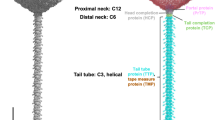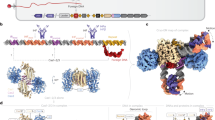Abstract
Bacteriophage Mu, a highly efficient transposon during its lytic cycle in Escherichia coli, is always associated with the host DNA1. In mature Mu particles, both ends of Mu are heterogeneous in length and sequence owing to the presence of host DNA2–6. The right end contains host sequences which vary between 500 and 3,200 base pairs (bp), while the left end heterogeneity was proposed7 to correspond to ∼50–100 bp. To understand the mechanism by which a small amount of host DNA at the left end is packaged along with Mu DNA, we have now determined the precise lengths of these host sequences. The minimum size of the host sequences attached to the left end of the mature bacteriophage Mu DNA is 56 bp; host sequences longer than 144 bp are rare. The host sequences do not show a continuum from 56 to 144 bp but are rather packaged in discrete blocks. The first such block is 56–61 bp, the second is 67–72 bp and so on. Thus, each block represents fragments covering a 5–6-bp range, with a space of 5 bp between each block. It seems that Mu DNA is being measured in units of helical turns for packaging.
This is a preview of subscription content, access via your institution
Access options
Subscribe to this journal
Receive 51 print issues and online access
$199.00 per year
only $3.90 per issue
Buy this article
- Purchase on Springer Link
- Instant access to full article PDF
Prices may be subject to local taxes which are calculated during checkout
Similar content being viewed by others
References
Bukhari, A. I. A. Rev. Genet. 10, 389–411 (1976).
Daniell, E., Kohne, D. E. & Abelson, J. J. Virol. 15, 739–743 (1975).
Bukhari, A. I., Froshauer, S. & Botchan, M. Nature 264, 580–583 (1976).
Daniell, E., Abelson, J., Kim, J. S. & Davidson, N. Virology 51, 237–239 (1973).
Bukhari, A. I. & Taylor, A. L. Proc. natn. Acad. Sci. U.S.A. 72, 4399–4403 (1975).
Chow, L. T. & Bukhari, A. I. in DNA Insertion Elements, Plasmids, and Episomes (eds Bukhari, A. I., Shapiro, J. A. & Adhya, S. L.) 295–306 (Cold Spring Harbor Laboratory, New York, 1977).
Allet, B. & Bukhari, A. I. J. molec. Biol. 92, 529–540 (1975).
Murialdo, H. & Becker, A. Microbiol. Rev. 42, 529–576 (1978).
Earnshaw, W. C. & Casjens, S. R. Cell 21, 319–331 (1980).
Streisinger, G., Emrich, J. & Stahl, M. M. Proc. natn. Acad. Sci. U.S.A. 57, 292–295 (1967).
Tye, B. K., Huberman, J. A. & Botstein, D. J. molec. Biol. 85, 501–532 (1974).
Gill, G. S. & MacHattie, L. A. J. molec. Biol. 104, 505–515 (1976).
Inman, R. B., Schnös, M. & Howe, M. Virology 72, 393–401 (1976).
Breepoel, H., Hoogendorp, J., Mellema, J. E. & Wijffelman, C. Virology 74, 279–286 (1976).
Maxam, A. M. & Gilbert, W. Meth. Enzym. 65, 499–560 (1980).
Author information
Authors and Affiliations
Rights and permissions
About this article
Cite this article
George, M., Bukhari, A. Heterogeneous host DNA attached to the left end of mature bacteriophage Mu DNA. Nature 292, 175–176 (1981). https://doi.org/10.1038/292175a0
Received:
Accepted:
Issue Date:
DOI: https://doi.org/10.1038/292175a0
This article is cited by
Comments
By submitting a comment you agree to abide by our Terms and Community Guidelines. If you find something abusive or that does not comply with our terms or guidelines please flag it as inappropriate.



